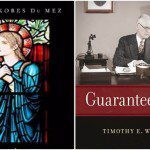I have just read an admirably concise essay that is one of the smartest and most interesting contributions to American religious history that I have read in a long time. In April, Jon Butler gave his Presidential Address to the Organization of American Historians, which has now been published as “God, Gotham, and Modernity,” in the Journal of American History (June 2016) 103 (1): 19-33: subscription is required.
To oversimplify the argument, Butler complains that scholars (past and present) tend to associate organized religion with the past, seeing it as the antithesis of modernity: it is something that people hang on to, however desperately. In fact, he shows, it provides indispensable tools for coping with modernity.
Briefly, Butler describes the ideas of Max Weber and William James about trends in religion in the early twentieth century, and specifically the role of institutional structures. He then shows how starkly they contrast with the richly thriving spiritual life so highly visible in the booming metropolis of New York City. Demonstrating the centrality of that religious life for the emerging city, Butler writes that,
The institutional proliferation so obvious among turn-of-the-century New York City Jews, Catholics, and Protestants raises questions about the perspectives of the era’s most observant intellectuals. Where Max Weber saw in bureaucracies, corporations, and modern institutions rigidity and, usually, secularity, in New York City institutions offered mechanisms through which religious groups grappled with anonymity, mobility, density, and indifference using multiple institutional forms in multiple circumstances. Where William James saw institutions, including individual congregations, as living “second hand upon tradition,” most New Yorkers came to religion through institutions as children and lived out their religious experience in institutions as adults, not always happily, as James Baldwin documented, but vividly.
The religious experience of these New Yorkers suggests that Weber and James bypassed something exceptionally important about the texture, energy, and resilience of American religion, at least between the 1880s to the 1920s: that this religious experience was powerfully collective, rooted in joining with others to share ritual, beliefs, and practice through a broad array of institutions indispensable to their achievement. Their actions, individual and institutional, created community, uplifting identity and connections to what they thought was important in religion. Rather than lures to secularization, modern institutions continued the historical adaptations that had long transformed Western religion and society…
Appreciating the often-unsexy history of modern religious institutions helps us grasp the varieties of religious experience that men and women created and re-created in modern New York City and across America, core instruments through which urban New Yorkers, and Americans, engaged belief, wonder, the enchanted, and the transcendent despite modernity’s steamroller, indeed many with it.
Reading such words, I cannot help but apply them precisely to the modern day experience of emerging churches in cities in Africa, Asia and Latin America.
I also think back to a recent posting of my own, about Ray Stannard Baker’s heavily New York-centered view of the “Spiritual Unrest” in 1910.
Anyway, Butler’s essay is terrific – do seek it out.
To nobody’s surprise, Butler’s website notes that “He is writing a book, God in Gotham, about religion in Manhattan from the Gilded Age to the Kennedy election.” That will be quite an event.
That is not to be confused with Paul Asay’s 2012 book God on the Streets of Gotham, which – of course – concerns Batman. Nor yet Lyndsay Faye’s popular crime novel The Gods of Gotham, set in New York City in 1845.












